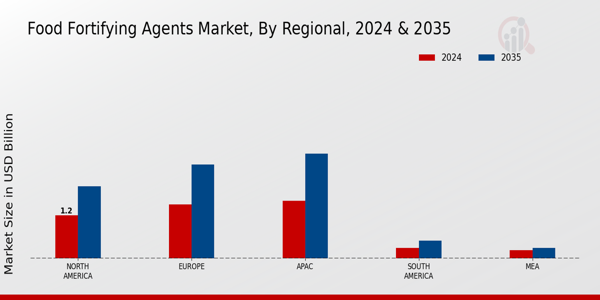Food Fortifying Agents Size
Food fortifying agents Market Growth Projections and Opportunities
The Food Fortifying Agents Market is influenced by a myriad of market factors that shape its dynamics and growth trajectory. One crucial determinant is the increasing consumer awareness and focus on health and wellness. As people become more conscious of their dietary choices, there is a growing demand for food products that offer additional nutritional benefits. This heightened awareness has spurred the adoption of food fortifying agents, which are substances added to food to enhance its nutritional content. Government regulations and policies also play a pivotal role in shaping the Food Fortifying Agents Market. Many countries have implemented regulations mandating the fortification of certain staple foods to address widespread nutritional deficiencies in their populations. These regulations create a conducive environment for the growth of the food fortifying agents industry, as food manufacturers are compelled to comply with these standards, thereby driving the market forward. The rise in the global population, coupled with changing lifestyles and dietary patterns, is another significant factor influencing the market. As more people shift towards processed and convenience foods, the need for fortification to compensate for nutrient losses during processing becomes crucial. This shift is particularly noticeable in urban areas where hectic lifestyles often lead to a reliance on packaged and processed foods. Consequently, food fortifying agents play a vital role in ensuring that these processed foods remain nutritionally balanced. Technological advancements also contribute to the dynamics of the Food Fortifying Agents Market. As food science and technology progress, new and more effective fortifying agents are developed. This constant innovation not only improves the efficacy of fortification but also opens up new avenues for market growth. Manufacturers are investing in research and development to create fortified products that not only meet nutritional requirements but also cater to diverse consumer preferences. Consumer preferences and tastes are ever-evolving, and this factor significantly impacts the Food Fortifying Agents Market. Taste and flavor are critical considerations for consumers, and fortifying agents must be incorporated into food products without compromising on sensory attributes. Manufacturers are thus challenged to strike a balance between nutritional enhancement and maintaining the palatability of the final product. Successful integration of fortifying agents into a wide array of foods, including snacks and beverages, helps in expanding market reach. Global economic conditions also exert influence on the Food Fortifying Agents Market. Economic stability and growth contribute to increased consumer spending power, enabling more people to afford fortified food products. Conversely, economic downturns may lead to a shift in consumer spending habits, with some opting for more affordable non-fortified alternatives. Therefore, the market's growth is intricately tied to the overall economic climate.














Leave a Comment